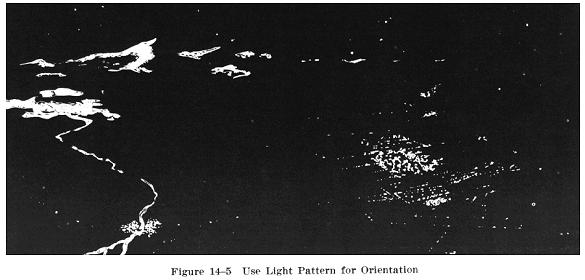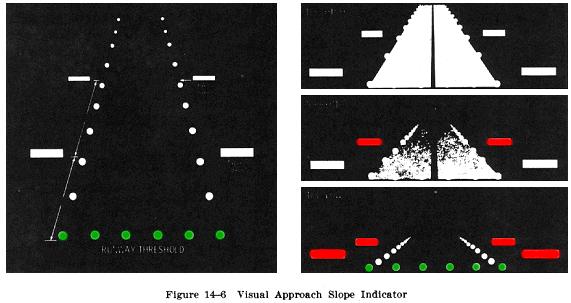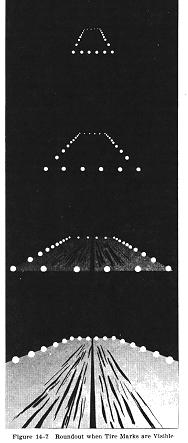| Landing Approaches and Landings
When arriving at the airport to enter the traffic pattern and
land, it is important that the runway lights and other airport lighting be
identified as early as possible. If the airport layout is unfamiliar to the
pilot, sighting of the runway may be difficult until very close in due to the
maze of lights observed in the area (Fig. 14-5). The pilot should, therefore,
fly towards the airport beacon light until the lights outlining the runway are
distinguishable. To fly a traffic pattern of the proper size and direction when
there is little to see but a group of lights, the runway threshold and runway
edge lights must be positively identified. Once seen, the approach threshold
lights should be kept in sight throughout the airport traffic pattern and
approach.

Distance may be deceptive at night due to limited lighting
conditions, lack of intervening references on the ground, and the inability of
the pilot to compare the size and location of different ground objects. This
also applies to the estimation of altitude and speed. Consequently, more
dependence must be placed on flight instruments, particularly the altimeter and
the airspeed indicator.
Inexperienced pilots often have a tendency to make approaches
and landings at night with excessive airspeed. Every effort should be made to
execute the approach and landing in the same manner as during the day. A low,
shallow, approach is definitely inappropriate during a night operation. The
altimeter and vertical speed indicator should be constantly cross checked
against the airplane's position along the base leg and final approach.
| After turning onto the final approach and aligning the
airplane midway between the two rows of runway edge lights, the pilot
should note and correct for any wind drift. Throughout the final approach,
power should be used with coordinated pitch changes to provide positive
control of the airplane, enabling the pilot to accurately adjust airspeed
and descent angle. Where a Visual Approach Slope Indicator is installed,
it is helpful in maintaining the proper approach angle (Fig. 14-6).
Usually, when approximately |
 |
halfway along the final approach, the
landing light should be turned on. Earlier use of the landing light may be
ineffective since the light's beam will usually not reach the ground from higher
altitudes, and may be reflected back into the pilot's eyes by any existing haze,
smoke, or fog. However, this disadvantage may be overshadowed by the safety
advantage provided by using the "Operation Lights On" procedure in the terminal
area.
| The roundout and touchdown should be made in the same manner as in day
landings. Judgment of height, speed, and sink rate is impaired, however,
by the scarcity of observable objects in the landing area.
The inexperienced pilot may have a tendency to roundout too high until
attaining familiarity with the apparent height for the correct roundout
position.
To aid in determining the proper roundout point, it may be well to
continue a constant approach descent until the landing light reflects on
the runway, and tire marks on the runway, or runway expansion joints, can
be seen clearly (Fig. 14-7). At that point the roundout for touchdown
should be started smoothly and the throttle gradually reduced to idle as
the airplane is touching down.
During landings without the use of landing lights or where marks on the
runway are indiscernible, the roundout may be started when the runway
lights at the far end of the runway first appear to be rising higher than
the airplane. This, of course, demands a smooth and very timely roundout,
and requires, in effect, that the pilot "feel" for the runway surface,
using power and pitch changes as necessary for the airplane to settle
softly on the runway. |

|
 |
FAATest.com
- Aviation Library
Dauntless
Software hosts and maintains this library as a service to pilots
and aspiring pilots worldwide. Click
here for ways to show your appreciation for this service.
While much of this material comes from the FAA, parts of it are (c) Dauntless Software, all rights reserved. Webmasters: please
do not link directly to individual books in this library--rather,
please link to our main web page at www.dauntless-soft.com or
www.faatest.com. Thanks! |
|



